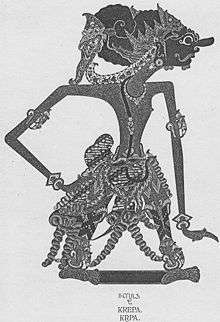Kripa
Kripa (Sanskrit: कृप, Kṛpa in IAST transliteration), also known as Kripacharya (Sanskrit: कृपाचार्य) or Krupacharya or better phonetically written as Kṛpāchārya is fourth Avatar of Brahma and is an important character in the Mahābhārata, one of the Chiranjivi. He was the son of Śaradvān and Jānapadī,[1] born in a particularly extraordinary manner. He was the grandson of Maharishi Gautama. He was a descendant of sage Angiras. He along with his sister Kripi were adopted by King Shantanu. Later on Kripa became an acharya, teacher of the royal children, giving him the name Kripacharya. His twin sister Kripi married Drona. Kripa was among the Maharathis who fought on the Kauravas's side against the Pandavas in the Kurukshetra war in the Hindu epic of the Mahabharata.[1][2] Along with others, Kripa is considered to be foremost among the rishis in Kaliyuga.[3] Kripa will also become one of the Saptarishi in the 8th Manvantara.[4]
| Kripa | |
|---|---|
 Kripa in Javanese Wayang | |
| In-universe information | |
| Position | Kul guru of Hastinapur, Cheeranjeevi, Saptrishi of eighth Manvatara |
| Family | Śaradvān (father) and Jānapadī (mother), Kripi (sister), Gautama maharishi(grandfather) |
| Relatives | Dronacharya(brother-in-law) |
Birth
Gautama Maharishi had a grandson called Śaradvān. Śaradvān was born with arrows, making clear he was a born archer. As he matured, he became such a great archer, and began doing penance to become an unbeatable one. This threatened the gods, especially Indra. He then sent a beautiful Apsara, Janapadi, from heaven to distract the celibate saint. Śaradvān was distracted by the sight of such a beautiful woman and lost some control, dropping his weapons and retreating into the forest to undergo more penance. His semen fell on some weeds by the wayside, dividing the weeds into two - from which a boy and a girl were born. The king of Hastinapura, Shantanu was crossing from there and saw the children by the wayside. He named them Kripa and Kripi, and decided to take them back with him to his palace.
Life

When Śaradvān came to know of these children he came to the palace, revealed their identity and performed the various rituals which are performed for the children of Brahmins. He also taught the children archery, the Vedas, and other Shashtras.
The children grew up to become experts in the art of warfare. Kripa was now assigned the task of teaching the young princes all about warfare. On reaching adulthood, Kripa was the chief priest at the court of Hastinapura. His twin sister Kripi married Drona, the weapons master to the court - who, like her and her brother, had not been gestated in a womb, but outside the human body. He fought in the great battle of Kurukshetra for the Kaurava side. He was one of the three survivors remaining from the Kaurava side. Afterwards, he was appointed to be the teacher and preceptor of Parikshit, the grandson of Arjuna.
Skill as a warrior
In Udyoga Parva of the Mahabharata, Bhishma declared Kripa as a mighty Maharathi, or a warrior capable of fighting 60,000 warriors simultaneously; circumspect in his mastery of all forms of weapons and combat skills.[5]
As noted in sloka given below, he is one of the seven Chiranjivin (the "immortals" who are to remain alive throughout the Kali Yuga.
- अश्वत्थामा बलिर्व्यासो हनुमांश्च विभीषणः। कृपः परशुरामश्च सप्तैते चिरंजीविनः ।।
References
- Varkey, C.P. (2001). A Pilgrimage ~ Through the Mahabharata. St Pauls BYB. pp. 22–. ISBN 978-81-7109-497-4.
- Sharma, Mahesh; Chaturvedi, B.K. (2006). Tales From the Mahabharat. Diamond Pocket Books (P) Ltd. pp. 42–. ISBN 978-81-288-1228-6.
- K M Ganguly(1883-1896). The Mahabharata,Book 13 Anusasana Parva,SECTION CL sacred-texts.com,October 2003,Retrieved 2014-02-11
- Vishnu Purana -Drauni or Asvathama as Next saptarishi Retrieved 2015-02-15
- K M Ganguly(1883-1896). The Mahabharata,Book 5 Udyoga Parva,Section CLXVIII sacred-texts.com,October 2003,Retrieved 2015-02-14

